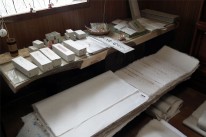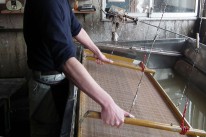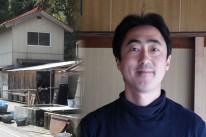Nishita Seishisho
Coporate Profille
Hiroshi Nishita, the representative of Nishita Seishisho, was born in Kyoto city. He moved to Mikumacho in 1993 and served as a Sekishu-Washi (a traditional type of Japanese paper) craftsman since then. He started his career almost 20 years ago; at the age of 39 he is the youngest factory representative of Sekishu-Washi in Mikumacho.
Nishita Seishisho washi is hand-made paper using the classical production process, starting from making materials, add kozo paper mulberries to paper mill. His policy is to work on anything demanded by the customers, so he deals with various kinds of products such as drawing papers. Mr.Nishita is a member of Sekishu-Hanshi creators’ committee, and one of the renowned traditional craftsmen of Sekishu-Washi.
Story
On the beginning of 8th century, Kakinomoto Hitomaro introduced Sekishu-Washi to Iwami on the beginning of 8th century, and the tradition of hand-made paper was preserved for 1300 years. A finished product need to undergone a long process. First, they use local kozoa paper mulberries, second, they steam them, third, raw woods are sliced, forth, they bark trees (Kurokawa-sozori) and finally they go through Kazushi, Choshi, Sutemizu and drying, which are typical process of paper making. The existing factories preserve the old way of making papers and were registered as important intangible cultural assets in 1967 and “Intangible Cultural Heritage of UNESCO” in 2009.
Interview
My family was a “paper family”; my father was running a paper processing industry in Kyoto and my grandfather used to work for a paper mill. Raised in this environment, I have been thinking about getting a job related to paper. Then, I went to my aunt’s factory in Mikumacho to learn the skills. At the peak period, there were more than 100 factories of Sekishu-Washi, but now only four remain in Mikumacho. It may take a few years to learn the processes and put them into practice. I know it is very hard to make a living with papermaking but I believe that there is a way as long as I keep motivating myself.
Recommendation
Hand-made Washi has various ways of distribution such as retail stores or processing industries. Representative products are Hanshi (sheets of plain paper for calligraphy), post cards, colored paper, Tanzaku (cards for writing haiku) and business cards. Some original products can be purchased through the web. Hanshi costs 1680yen for 20 sheets. The enduring process of making papers from growing raw woods to paper mill guarantees our products’ superior quality. The largest size of papers that Nishita Seishisho deals with is 100cm long and 176cm wide. They are used for Shoji (a type of Japanese room partition with a wooden frame holding a wooden or bamboo grid) or Fusuma. Since they are produced based on order, it takes more than one month from receiving an order till the delivery of the goods. Their policy is to fulfill any request from customers. An odd example is the paper produced by Nishita Seishisho is used as a material of Kaguramen (a kind of masks) for Iwami Kagura. This factory owns customers even in Hiroshima because Iwami Kagura originates from the northwest part of Hiroshima. Mr.Nishita raises kozoa paper mulberries in his factory-owned farm and deals with all the process from material to the products. He values his works greatly and does not compromise any process of the production. This involves converting kozoa paper mulberries in paper mill and remains the exclusivity in the whole production process.




